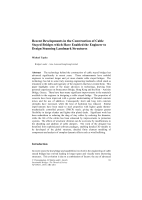Bridges

- Publication no: ABC-DES034-11
- Published: 31 October 2011
- PDF (free) Download
The technology behind the construction of cable stayed bridges has advanced significantly in recent years. These enhancements have enabled engineers to construct longer and yet more slender cable stayed bridges. The technology has led to some truly stunning engineering landmarks which stand as testament to the skills and ingenuity of the engineers that have created them. This paper highlights some of the major advances in technology, drawing from personal experiences on Stonecutters Bridge, Hong Kong and the Rion – Antirion Bridge, Greece. There have been many significant improvements in the materials available to the engineer in designing a cable stayed bridge. The properties of concrete have been improved with a greater understanding of blended concrete mixes and the use of additives. Consequently short and long term concrete strengths have increased, while the heat of hydration has reduced. Similar improvements have been made to steel properties with higher grade thermo-mechanically controlled process (TMCP) steels, giving the designer greater flexibility to design slender and lighter thin plated decks. Significant work has been undertaken in reducing the drag of stay cables by reducing the diameter, while the life of the cables has been enhanced by improvements to protection systems. The effects of wind-rain vibration can be overcome by modifications to the sheathing and addition of cable dampers. The work of the designer has benefited from sophisticated software packages, enabling detailed 3D models to be developed of the global structure, detailed finite element modeling of components and analysis of complex dynamic effects such as wind buffeting.
